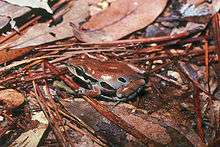Ornate chorus frog
The ornate chorus frog (Pseudacris ornata) is a species of chorus frog endemic to the Southeastern United States.
| Ornate chorus frog | |
|---|---|
 | |
| Scientific classification | |
| Kingdom: | Animalia |
| Phylum: | Chordata |
| Class: | Amphibia |
| Order: | Anura |
| Family: | Hylidae |
| Genus: | Pseudacris |
| Species: | P. ornata |
| Binomial name | |
| Pseudacris ornata (Holbrook, 1836) | |
| Synonyms[2] | |
| |
Description
It is 25–38 mm (1–1.5 in) in head-body length. Its color varies depending on locale: some are green, others red or brown. It typically has a defined but broken stripe or spots leading from the nose down the side. It has a pure white belly, and usually has yellow spots located in front of the hind legs.
Habitat
Most commonly found in the Southern coastal plain, they live in longleaf pine flatwoods.
Behavior
These chorus frogs are nocturnal and are rarely seen, except during mating season.
Taxonomy
The ornate chorus frog (Pseudacris ornata) was named and classified by American herpetologist John Edwards Holbrook in 1836.
Etymology
The name of the genus, Pseudacris, comes from the Greek pseudes (false) and akris (locust), probably a reference to the repeated rasping trill of most chorus frogs, which is similar to that of the insect. The specific name, ornata, is the feminine form of the Latin adjective, ornatus (decorated).
References
- Hammerson (2004). "Pseudacris ornata". IUCN Red List of Threatened Species. 2004. Retrieved 12 May 2006.CS1 maint: ref=harv (link)
- Amphibian Species of the World 5.6 an Online Reference. American Museum of Natural History. research.amnh.org/vz/herpetology/amphibia/.
| Wikimedia Commons has media related to Pseudacris ornata (Ornate chorus frog). |
